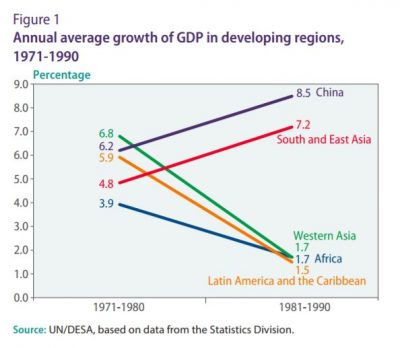
The World Economic and Social Survey 2017 reviews the discussions on development presented in WESS over the past seventy years. The objective is to bring the insights and the historical experience of 70 years of development policy analysis to inform the implementation of the 2030 Agenda for Sustainable Development. This note is a brief review of developments in the 1970s and 1980s. After almost three decades of remarkable progress since the end of the Second World War, economic conditions started to deteriorate in the 1970s. Economic growth slowed down in all parts of the world during the second half of the 1970s and the first half of the 1980s. Before the oil price shock of 1973, the annual growth of world gross product had been at 5.3 per cent, while during the rest of the 1970s, annual world growth reached only 2.8 per cent.
The global economic turmoil in the 1970s and 1980s, cast a shadow over the Second (1971-1980) and Third (19811990) United Nations Development Decade. These development agendas were ambitious and multidimensional, but the deteriorating economic situation led to a focus on short-term economic policies at the expense of longer term development goals. This experience demonstrates how easily the commitment to internationally agreed development goals can evaporate in times of economic difficulties, and highlights in turn the importance of a stable global economic environment for upholding the commitment to implement ambitious development agendas. Although the current situation of slow growth has different underlying causes, it shares a surprising number of characteristics with the slowdowns of the 1970s and 1980s. The analysis of this period and many of the policy discussions still resonate in 2017, as policymakers attempt to grapple with a global economic slowdown. There are several important implications to be drawn from the experience of this period — implications for the implementation of the 2030 Agenda for Sustainable Development and the Addis Ababa Action Agenda of the Third International Conference on Financing for Development.
Stagflation and debt crises: importance of global policy coordination
The decade of the 1970s began with the breakdown of the post-Second World War consensus on the global economic governance architecture, as embodied in the Bretton Woods system. The decade also witnessed two oil price shocks and the persistence of high inflation and unemployment—referred to as stagflation—in several developed countries. Lack of international coordination meant that weak growth, high inflation and high unemployment became the norm in most developed countries throughout the 1970s. As a result, a difficult global economic situation confronted the world as it entered the 1980s—a situation characterized not only by high inflation and unemployment (internal imbalance) in developed countries, but also large deficits in the current account of the balance of payments (external imbalance) in several developed and developing countries. In addition, lower demand in developed countries led to a decline in commodity prices and a deterioration of the terms of trade for many developing countries dependent on commodity exports. Given the difficult economic situation, many countries, especially in Latin America and the Caribbean, and Africa experienced an increase in debt levels in an attempt to keep economies growing. This was fostered in part by the recycling of abundant petrodollars by the financial institutions of developed countries. In this context, the steep increase in interest rates in the United States of America to combat inflation at the turn of the decade increased the cost of debt service and triggered debt crises in many countries in these regions. The prolonged and painful adjustment process in the 1970s and 1980s could have been shortened and reduced through more coherent and internationally coordinated action of monetary and fiscal policy. This highlights the importance of such international economic policy coordination and coherence, and the application of a variety of policy measures designed to maintain economic stability and curtail the duration of economic crises.
The lost decade of development: high social cost of fiscal austerity
The debt crisis of the 1980s led to a severe recession in almost all African and Latin American countries. Countries in debt distress faced strong pressures to avoid default and to implement fiscal consolidation, often imposed through conditionality for financial support. This only exacerbated the cost and the duration of the crisis. There was narrow focus on austerity and rapid budget adjustment, often neglecting the high social and economic costs. Governments were pressured to cut back on social spending and infrastructure investment as part of the adjustment process, which had long-term implications. Both in Latin America and the Caribbean, and Africa, the economy took more than a decade to recover, and the 1980s has since been referred to as the lost decade of development. The high cost of the debt crisis in the 1980s, demonstrates how fiscal consolidation alone cannot resolve a debt crisis: fiscal austerity, when needed, must constitute one component of a larger strategy for development. There should be more emphasis on long-term debt sustainability rather than a strict focus on short-term balancing of current budget deficits. The experience in Latin America also underlined the importance of giving sufficient consideration to the human and social cost of adjustment and protecting social spending and productive investment in times of adjustment. In response to the debt crisis in the 1980s there was close coordination among creditors towards guaranteeing debt repayment; unfortunately, there was lack of proper coordination among debtors, so as to enable a fairer distribution of the costs of debt restructuring. More responsible lending and borrowing should be promoted in order to reduce the likelihood of debt crises, and a debt workout mechanism could ensure a faster and fairer resolution of such crises.
Divergence in economic performance: flexible policy space and country ownership
 While all developing regions enjoyed relative robust growth in the 1970s, the experience of the 1980s was marked by dramatic economic divergence as various developing regions adopted different development strategies and policies (see figure 1). On the one hand, the deteriorating global economic situations adversely impacted countries in Africa, Latin America and the Caribbean, and Western Asia, which in the 1980s experienced a lost decade of development. On the other hand, most countries in South and East Asia were more resilient and were able to keep economic dynamism. This contributed to a great divergence of economic performance among developing regions. This divergence served to reinforce confidence in development narratives that were alternative to the one disseminated under the Washington Consensus. While countries in Latin America and the Caribbean, and Africa were under pressure to apply fiscal restraint and deregulation of markets, countries of East Asia defied the trust in unfettered markets that had been reflected in the Washington Consensus. While East Asian countries varied greatly in their economic policies, they shared a common feature: the central role of the State. They developed the concept of the development State, where the State leverages markets to promote development. The successful experience of countries in East Asia provided a marked contrast to the lost decade of development in Latin America and the Caribbean, and Africa. The experience in Latin America and the Caribbean, and Africa in the 1980s attests to the potential long-term consequences from the imposition of a specific development narrative upon countries, and highlights the importance of country ownership and home-grown national strategies. Stringent policy conditionality in exchange for financial support may have very negative impacts on development. The failure of the “one-size fits all” approach to development promoted by the Washington Consensus demonstrates the danger of adhering to a single prescriptive model for producing stable growth and development. Prepared by Kenneth Iversen, under the supervision of Diana Alarcón UNDESA, DPAD. This document was prepared in the context of the World Economic and Social Survey 2017. The opinions expressed here do not necessarily represent the views of the United Nations.
While all developing regions enjoyed relative robust growth in the 1970s, the experience of the 1980s was marked by dramatic economic divergence as various developing regions adopted different development strategies and policies (see figure 1). On the one hand, the deteriorating global economic situations adversely impacted countries in Africa, Latin America and the Caribbean, and Western Asia, which in the 1980s experienced a lost decade of development. On the other hand, most countries in South and East Asia were more resilient and were able to keep economic dynamism. This contributed to a great divergence of economic performance among developing regions. This divergence served to reinforce confidence in development narratives that were alternative to the one disseminated under the Washington Consensus. While countries in Latin America and the Caribbean, and Africa were under pressure to apply fiscal restraint and deregulation of markets, countries of East Asia defied the trust in unfettered markets that had been reflected in the Washington Consensus. While East Asian countries varied greatly in their economic policies, they shared a common feature: the central role of the State. They developed the concept of the development State, where the State leverages markets to promote development. The successful experience of countries in East Asia provided a marked contrast to the lost decade of development in Latin America and the Caribbean, and Africa. The experience in Latin America and the Caribbean, and Africa in the 1980s attests to the potential long-term consequences from the imposition of a specific development narrative upon countries, and highlights the importance of country ownership and home-grown national strategies. Stringent policy conditionality in exchange for financial support may have very negative impacts on development. The failure of the “one-size fits all” approach to development promoted by the Washington Consensus demonstrates the danger of adhering to a single prescriptive model for producing stable growth and development. Prepared by Kenneth Iversen, under the supervision of Diana Alarcón UNDESA, DPAD. This document was prepared in the context of the World Economic and Social Survey 2017. The opinions expressed here do not necessarily represent the views of the United Nations.
 Welcome to the United Nations
Welcome to the United Nations


